In 1995, the Society for Music Theory established its Professional Development Committee, which selected as an initial area of inquiry "How many music theory jobs are available each year?"1 While employment prospects occupy the thoughts of prospective and recent graduates, the availability of academic jobs concerns a wider circle of people. The topic, for example, is frequently discussed in The Chronicle of Higher Education, and this journal published in 1989 Wayne Slawson's report "Retirements and Demand for Ph.D.s in Music, 1988-2000."2 The goal of the present study is to determine how many positions advertised in the College Music Society's Music Vacancy List from September 1984 through August 1997 sought to hire music theorists.3
Music theory is a young academic discipline. Patrick McCreless, in his article "Rethinking Contemporary Music Theory" dates the rise of music theory
to about 1960, when the "professional music theorist" came onto the scene—that is, when "music theory" in American universities began to define itself as a discipline distinct from musicology, on the one hand, and composition, on the other, and when a few music schools began to employ music theorists rather than composers, musicologists, or performers who also taught theory, to administer their music curricula. The birth of the new academic discipline was also marked by the establishment of the Journal of Music Theory, the first journal devoted to the new field, at Yale in 1957, and of Perspectives of New Music at Princeton in 1962; and, within the next decade, numerous graduate programs at both university music departments and conservatories.4
If the viability of a discipline is measured by its journals and graduate programs, then music theory has earned membership in the academy. Presently, more than 10 journals are dedicated solely to the field. Music Theory Spectrum, first issued in 1979, and Music Theory Online, initiated in 1993, are the two peer-reviewed publications sponsored by the Society for Music Theory, which was organized in 1977.5 In addition, several universities and a handful of regional music theory societies sponsor refereed journals.6 McCreless also notes that "in 1950 no American university offered a Ph.D. in music theory."7 Today, more than 30 universities in the USA and Canada offer the degree; and, this number increases to more than 40 when those universities that offer theory as an area of emphasis under the rubrics of either composition or musicology are included.8
The results presented herein focus on the job market for contributors and readers of the numerous music theory journals and for recipients of doctoral degrees in music theory. To be certain, some music departments, presumably smaller ones, adhere to the former convention of hiring composers or performers to teach music theory courses. It cannot be disputed, however, that since mid-century, music theory has taken its place in academia. "American music theory occupies a central place in undergraduate and graduate music curricula, provides jobs for its practitioners, supports a vital academic society, produces countless volumes of research and pedagogical materials, exports its ideas, and serves as a model for fledgling disciplines of music theory in Europe and elsewhere."9
Methodology
The source for advertised job postings was the Theory/Composition section in the CMS Music Vacancy List. A position was counted only once, even though it may have been advertised in several consecutive issues. That an advertised position required the teaching of music theory was the basic criterion for inclusion in this study. Thereby, those descriptions that required teaching composition exclusively or in which music theory was only a desired teaching area were not tallied.10 Also encountered were incomplete descriptions that named the school advertising an available position, but referred the reader to another section of the MVL. If access to other sections was available and the description met the basic requirement for inclusion in the study, then the complete description was surveyed for this report. Also, only positions within Canada and USA were included.
Information contained in each description was divided into several fields: academic year in which a job was to begin, school type, entry rank, contract terms, teaching responsibilities, and candidates' qualifications. For some fields—namely academic year, school type, entry rank, and contract terms—only one answer was possible. School type was determined solely by the name of an institution: university, college, conservatory, and college-conservatory. Remaining institutions were classified as "other." Contract terms included seven possibilities: tenured, tenure-track, renewable contract, temporary, negotiable, other, and undefined. Entry rank was divided into two broad categories: senior level and junior level. Senior level included only those descriptions that specified "Professor," or combined "Professor" with a lower rank, such as "Professor/Associate." Junior level, on the other hand, included many more titles, singly and in combination: associate professor, assistant professor, lecturer, and instructor. The categories negotiable, other, and undefined were also options in this field.
In the two remaining fields—teaching responsibilities and candidates' qualifications—more than one answer was possible. The former was particularly complex. Some descriptions simply announced the need for a music theorist, which implied a teaching load of music theory only, while others listed specific courses in the music theory curriculum that the candidate should be prepared to teach, such as counterpoint, ear training, freshman harmony, or Schenkerian analysis. Some required a theorist to teach non-theory subjects and listed a range of possible teaching areas, such as composition, applied music, or music history, while others desired the candidate to be proficient in at least one non-theory teaching area. For positions that state required and/or desired non-theory teaching areas, all the subjects referred to were tallied. Furthermore, tasks such as "direct jazz ensemble" were counted twice: once under "jazz" and again with "ensembles."
Many job postings sought a variety of qualifications in a candidate; however, three general areas were discernible: teaching experience, academic credentials, and professional activity. When collating the data, no distinction was made between criteria that were required and those that were desired. Categories within academic credentials included Ph.D./D.M.A completed, Ph.D./D.M.A. preferred or ABD, Ph.D. or equivalent, and Masters (minimum). The category Publications / Performances included the following phrases describing professional activity:
"potential for scholarly achievement,"
"evidence of potential for scholarly contributions,"
"demonstrated record of professional activity,"
"professional musical work of high distinction as theorist, composer, conductor, performer."
And finally, many job descriptions also included information that did not readily belong in any one field. The following statements are typical of those excluded from the report:
"also expected to participate fully in dept placement exams and meetings as scheduled"
"conduct research and pursue related professional activities"
"assist with student advising, recruiting, and participate in academic affairs"
"thesis supervision"
"serve on departmental/schl/doctoral advisory committees; direct research/area of expertise"
"firm commitment to undergrad teaching"
"capacity to mentor gifted grad students in original scholarly work"
"supervise grad TAs"
"demonstrate keyboard ability"
"maintain a high level of personal scholarship and creativity"
"work with existing faculty in the area to develop and maintain vigorous grad and undergrad programs in theory"
"ability to communicate effectively with an ethnically and culturally diverse campus community."
General Observations
Universities account for the majority of institutions advertising academic positions in the Theory/Composition section of the MVL. As we might expect, tenure-track positions appear most often, and in general, tenured positions least often. Over the thirteen-year span, jobs advertising a renewable contract hovered around 5% a year, while the market for temporary appointments averaged 16.8%. This figure is certainly low, because an unknown portion of short-term jobs are not advertised in the MVL. Each year, more than 10% of the job descriptions leave contract terms undefined. The trend since 1985-86, when almost 40% fell into this category, has leaned toward greater specificity. A low of 11.8% occurred in 94-95, though the figure has increased slightly in the years since. Certainly, a portion of the undefined percentage were tenure track, even though the job description omitted this information. For this reason, the actual number of available tenure-track positions is greater than we can indicate. In fact, the quantity of job announcements in any given year for which the contract terms were negotiable, other, or undefined is substantial enough to alter significantly the figures in the remaining categories. This generalization also holds true for entry rank, in which, as expected, junior-level positions were most common and the number of senior-level positions was often nil.
Results for the two fields in which multiple answers were possible—teaching responsibilities and candidates' qualifications—are discussed in separate sections below.
Results
This report presumes that for a music theorist entering the market the most commonly desired academic job is a junior-level tenure-track position that requires teaching only music theory. Example 1 presents the thirteen-year average and tallies by academic year the number of advertised jobs that adhere to the presumed ideal. For junior-level tenure-track positions, the average was 10.5 jobs. The number of positions in 1985-86 and 1988-89, at 5 and 4 respectively, was less than half the average, while in 1989-90, the 20 positions almost doubled the average. The remaining years were closer to the average, ranging from 8 in 1986-87 to 14 in 1991-92.
Example 1. Music Theory Only: Junior-Level Entry Rank and Tenure-Track Contract.
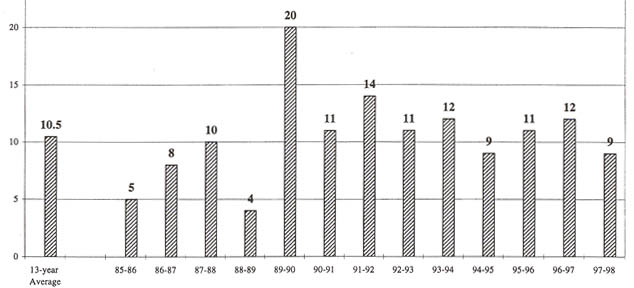
Examples 2 and 3 will build on Example 1 in that when the entry rank is maintained as a constant, the contract term is varied, and vice versa. As shown on the table below, example 2 will contain data about junior-level positions with regard to contract terms other than tenure track, namely renewable or temporary positions, and those that leave the field negotiable or undefined. Example 3 will present two additional combinations, one in which a tenure-track contract is paired with a negotiable or undefined entry rank. The final combination allows for both entry rank and contract terms to be negotiable or undefined.
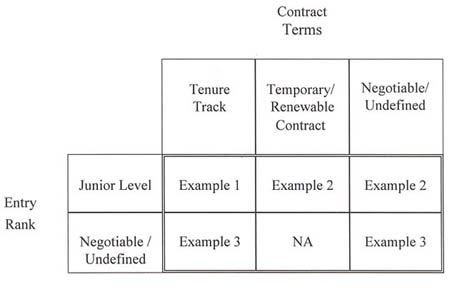
Example 2 adds to the data presented in Example 1, which is represented by the bottom segment of each bar. The middle segment represents junior-level positions that offered temporary or renewable contracts. The average for this combination of fields was 3.5 jobs. The top segment of each bar shows the number of junior-level positions for which the contract terms were negotiable or undefined. This average was 4.3. Thereby, the average number of junior-level positions, without regard to contract terms, was 18.3, which almost doubles the average reported in Example 1.
Example 2. Music Theory Only: Junior-Level Entry Rank and Various Contract Terms.
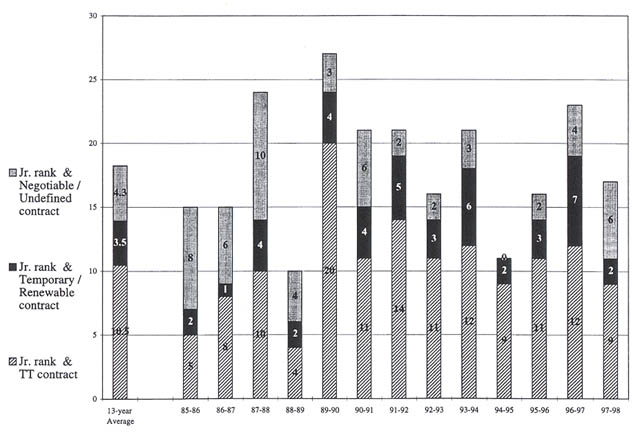
Example 3 continues to expand the information contained within the previous examples. When a negotiable or undefined entry level is combined with a tenure-track position, the average increases by 1.3 jobs, though in 1985-86, 1994-95, and 1997-98, no job announcements fit this pairing. The top segment of each bar allows both fields to be negotiable or undefined. This combination adds 4.4 jobs to the average. Therefore, the average number of jobs for which a music theorist entering the market and seeking to teach only music theory could apply is 24.
Example 3. Music Theory Only: Various Entry Ranks and Contract Terms.
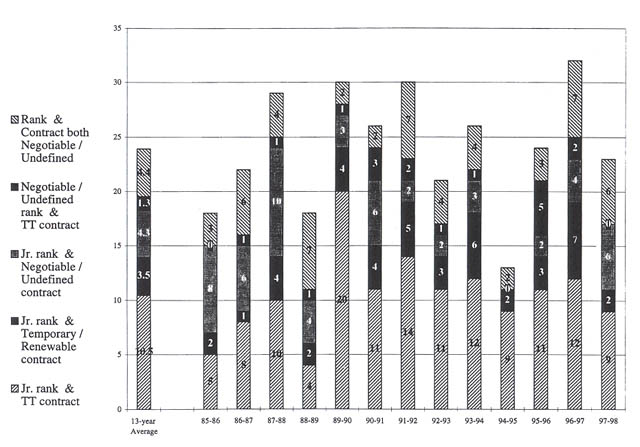
Given the historical ties between music theory and composition, it was not unexpected that the most frequently required teaching area paired with theory was composition. Example 4 tallies the number of junior-level tenure-track jobs that combine these two areas. As the first bar shows, an average of 9.4 such jobs were available each year. While two years—1988-89 and 1994-95—reached the same high of 13 jobs, and 1986-87 offered a low of 5, the majority do circulate about the average.
Example 4. Theory and Composition: Junior-Level Entry Rank and Tenure-Track Contract.
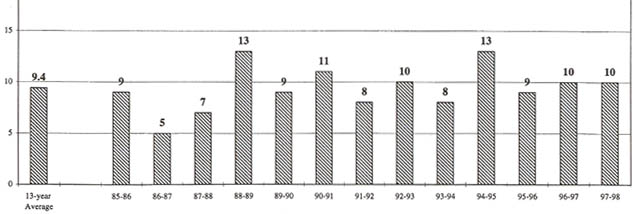
Examples 5 and 6 will build on Example 4 in the same way that Examples 2 and 3 expanded Example 1, and will yield similar results. Example 5 reveals that the junior-level temporary or renewable contract situation adds an average of 1.8 jobs per year, while the junior-level negotiable or undefined contract adds 3.5 jobs to the average. Thus, by varying the contract terms, the average number of junior-level jobs that required teaching theory and at least composition jumps from 9.4 to 14.7 positions.
Example 5. Music Theory and Composition: Junior-Level Entry Rank and Various Contract Terms.
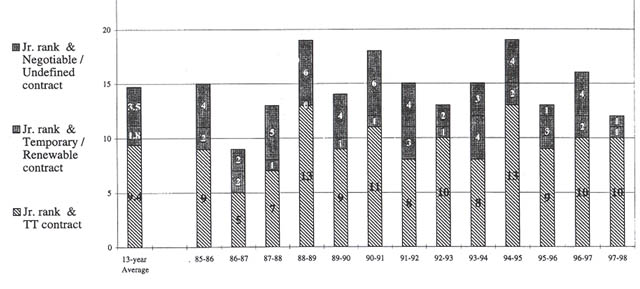
Example 6 increases the number of theory/composition jobs by varying the parameters in two ways. First, it combines positions that advertised a negotiable or undefined entry rank with a tenure-track contract. In four of the thirteen years surveyed—1985-86, 1986-87, 1992-93, and 1995-96—there were no advertised jobs that fit this description. On average though, 1.5 such jobs were available each year.
Example 6. Music Theory and Composition: Various Entry Ranks and Contract Terms.
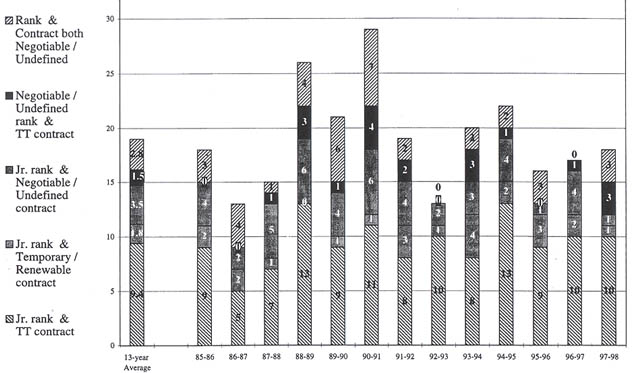
Allowing both entry-level and contract-type to be negotiable and/or undefined increases the number of jobs requiring theory and at least composition yet again. As Example 6 shows, this combination adds an average of 2.8 jobs per year. While we cannot be sure that all of these negotiable and undefined positions were in actuality entry-level jobs, we presume that some were. The end result—and this is also shown in example 6—is that an average of 19 job descriptions each year sought an applicant who was qualified to teach both theory and composition. While not the case every year, on the average this is fewer available jobs than those that require teaching only music theory.
Teaching Areas
The side-by-side tables in Example 7 compare specific non-theory teaching areas cited in job descriptions; required areas appear on the left and desired on the right. Within each, subjects are ranked according to frequency, which is the number of times a subject was requested. Not all job advertisements required non-theory teaching areas, and those that did often specified a range of areas, seeking proficiency in at least one. Among required areas, Composition ranked first, occurring almost twice as often as second-place Applied Music. It is interesting to note that Composition slipped to fourth place among desired non-theory areas. When compared to Composition, expertise in Electronic Music/MIDI and Computer-Assisted Instruction (CAI) traversed an opposite path, ranking third and sixth respectively among required fields, yet rising to first and a close second among desired areas. We should note, however, that Electronic Music/MIDI and CAI are often viewed as subfields of composition and music theory, respectively. We separated these technology-related topics in order to examine the demand for these skills. Thereby, those jobs for which CAI was the only "non-theory" required teaching area were not tallied with the theory-only positions presented in Examples 1-3. Allowing that CAI is a subfield of theory—in the same way that musicianship, post-tonal analysis, and history of theory are—then the number of theory-only positions increases by a total of 15 for the thirteen years surveyed. Seven of these occurred during the nine-year span from 1985-86 to 1993-94, while the remaining eight appeared in the four most recent academic years.
Example 7. Required Non-Theory Teaching Areas vs. Desired Non-Theory Teaching Areas.
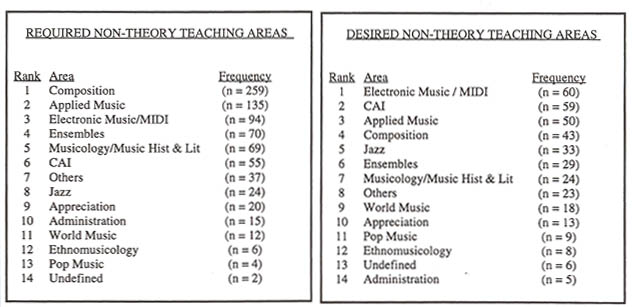
Examples 8 and 9 examine the data for each academic year. In general, trends within any given area are not discernible; however, a few observations are noteworthy. For example, Jazz, whether required or desired, was typically cited only two or three times a year. Yet in 1997-98, the demand sharply increased to six when required and seven when desired. In recent years, requests for World Music and Pop Music also increased. Over the past four years, World Music was required six times, compared to four during the initial nine years of the survey. Its growth as a desired area is more striking: between 1994-95 and 1997-98 World Music was listed 12 times versus five for all prior years. Pop Music underwent a similar growth spurt, particularly as a desired area.
Example 8. Required Teaching Areas by Academic Year.
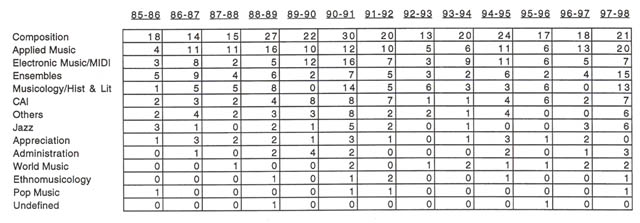
Example 9. Desired Non-Theory Teaching Areas by Academic Year.
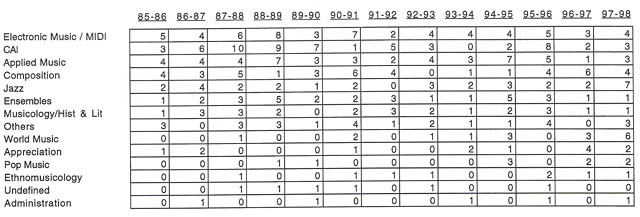
Candidates' Qualifications
Up to this point, we have reported on specific combinations of information gathered from each job advertisement, for example junior level / tenure track / theory only, or junior level / temporary contract / theory and at least composition. The data for candidates' qualifications was drawn from the entire thirteen-year survey of job descriptions without regard to school type, entry rank, contract terms, or teaching responsibilities.
Example 10 contains four sets of numbers for each year. The bars measure teaching experience and publications / performances, while the lines represent the most commonly requested academic credentials. These values are percentages of the total number of jobs surveyed. Recall that in this field, multiple answers were possible; thereby, the sum of the percentages in any given academic year exceeds 100%. Teaching experience was the quality most sought after in an applicant, consistently exceeding requests for a doctoral degree or its equivalent. The average difference between these two qualifications was 12%, although in 1989-90, 1990-91, 1992-93, and 1993-94 it was less than 6%. The most recent year displayed the greatest disparity between requests for teaching experience and a Ph.D./ D.M.A.; at 40% it more than doubled the difference for any other year.
Example 10. Candidate's Qualifications.
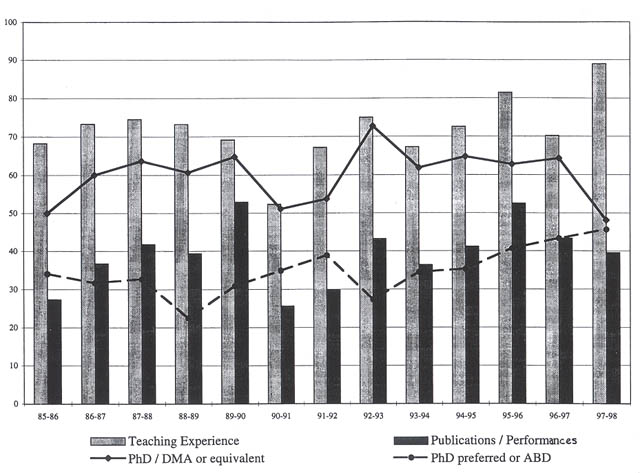
Conclusion
This report provides for the first time detailed information about the quantity of positions advertised in the CMS MVL that required teaching music theory from 85-86 through 97-98. It also examines specific features of each job, such as school type, entry rank, contract terms, teaching responsibilities, and candidates' qualifications. Certainly, the figures do not account for all the open positions in any given year because not every available job was advertised in the CMS MVL. It does, however, summarize a view of the market for Ph.D.s in music theory. A complementary picture would be the number of people actually seeking jobs in a given year. This figure is difficult to determine because it includes new Ph.D. recipients, recent graduates, and employed theorists seeking a new position. Nevertheless, the data presented herein can establish relative norms for this young, growing academic discipline.
1As a member of SMT's Professional Development Committee, the second author of this article designed the project, supervised the research, and presented the results at the 1996 SMT conference in Baton Rouge, LA. This project required countless hours of data entry, of which only a portion was completed by the authors. Colleagues at Harvard UniversityAlan Gosman, Ed Gollin, and Karem Alzandall brought humor with their willingness to work. Moreover, we extend a gracious word of thanks to Hali Fieldman, whose dedication to the data-entry portion of the project ensured its completion.
2 The present article is not a follow-up to Slawson's, nor is it valid to compare the results. Slawson's goal was to predict the need for new Ph.D.s to fill anticipated vacancies on music faculties. Not only were his data collected during an era of mandatory retirement, but it also combined information for music theory, composition, and musicology, whereas the present article examines the market for Ph.D.s in music theory only. Two well-known books on the topic of academic employment include William G. Bowen and Julie Ann Sosa, Prospects for Faculty in the Arts and Sciences: a Study of Factors Affecting Demand and Supply, 1987 to 2012 (Princeton: Princeton University Press, 1989) and William G. Bowen and Neil L. Rudenstine, In Pursuit of the Ph.D. (Princeton: Princeton University Press, 1992).
3The CMS Music Vacancy List was selected as the only source of data for this report because it was perceived to be the primary publication advertising college-level jobs in music for the years surveyed. The authors express appreciation to Robby D. Gunstream and Carol Ritter Boyd of The College Music Society for providing necessary copies of the Music Vacancy List.
4Patrick McCreless, "Rethinking Contemporary Music Theory," in Keeping Score: Music Disciplinarity, Culture, ed. David Schwartz, Anahid Kassabian, and Lawrence Siegel (Charlottesville and London: University Press of Virginia, 1997), 15.
5Richmond Browne, "The Inception of the Society for Music Theory," Music Theory Spectrum, 1 (1979) 2-5. Browne records that the idea for a national society was voiced at the 1975 joint meeting of The College Music Society and the American Society of University Composers, following a report on the Music Theory Society of New York State, which had been organized in 1973. The "First National Conference on Music Theory," held in 1976, and the second in 1977 preceded the first SMT national conference in 1978, which was a joint meeting with AMS.
6In the 1980s three European publications joined the collection: England's Music Analysis, France's Analyse Musicale, and Germany's Musiktheorie.
7McCreless, 33.
8International Society of Music Education, The International Directory of Music and Music Education Institutions (Australia: International Society of Music Education, 1996).
9McCreless, 33.
10An average of 7.8 composition-only positions were excluded per year from this report. This number includes all composition-only positions, regardless of entry rank and contract terms.


